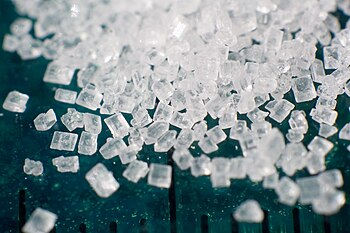684
| These tiny grains could be your next dose of antibiotics (Photo credit: Wikipedia) |
We have all heard of antibiotic resistance, notoriously of the MRSA and the need to use antibiotics sparingly. One major reason that antibiotic resistance scares us is because we do not have sufficient alternatives available with us to combat a resistant strain. For example, the microbes belonging to Burkholderia sp. can be naturally resistant to about 35 antibiotics agents as was shown in this 2004 research paper and therefore provide a small window of opportunity for treatment if contracted.
The solution to this problem is to develop new age antibiotics. The problem here, however, is that the pace of discovery is much slower than the growing pace of antibiotic resistance and at this rate we will soon have microbes that are resistant to every antibiotic in our armoury. The way out of this is to understand the psyche of the microbes and develop antibiotics that microbes are not going to develop resistance. Are we talking about microbial psychology here?
Not really. The trick is to use something that the microbe finds too dear to try and develop resistance to. And sugar is the answer. Not sugar as you and I love to consume but sugar that holds the cell wall of microbes together
 |
| The figure above shows a section of the bacterial cell wall (Gram Negative organisms) which consists of an outer membrane and an inner membrane. Note the words ‘sachharides’ and ‘glycan’ used in the image, which are all forms of sugar needed in large numbers by the organism uses to build up its bodily defenses. The process of building up this cell wall is the target for the popular antibiotics that we use today. |
Researcher Matt Cooper at the University of Queensland and his team of researchers from Taiwan, Belgium and the UK have now developed modified sugar compounds that stop the process of building the cell wall and thereby leading to reduced infection. Unlike traditional antibiotics that need to be isolated naturally and then tested, these modified sugar molecules have a common sugar core and using advanced computing researchers can come up with potentially thousands of compounds that will work as antibiotics in little time.
Since the core of the antibiotic is still a sugar that the organism needs, the chances that will develop resistance to its own building block will be very little.
References
Thibault FM, Hernandez E, Vidal DR, Girardet M, & Cavallo JD (2004). Antibiotic susceptibility of 65 isolates of Burkholderia pseudomallei and Burkholderia mallei to 35 antimicrobial agents. The Journal of antimicrobial chemotherapy, 54 (6), 1134-8 PMID: 15509614
Zuegg J, Muldoon C, Adamson G, McKeveney D, Le Thanh G, Premraj R, Becker B, Cheng M, Elliott AG, Huang JX, Butler MS, Bajaj M, Seifert J, Singh L, Galley NF, Roper DI, Lloyd AJ, Dowson CG, Cheng TJ, Cheng WC, Demon D, Meyer E, Meutermans W, & Cooper MA (2015). Carbohydrate scaffolds as glycosyltransferase inhibitors with in vivo antibacterial activity. Nature communications, 6 PMID: 26194781


